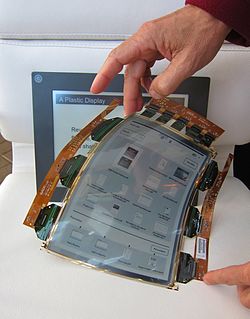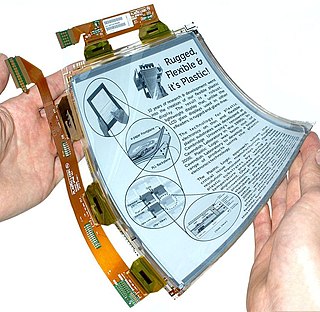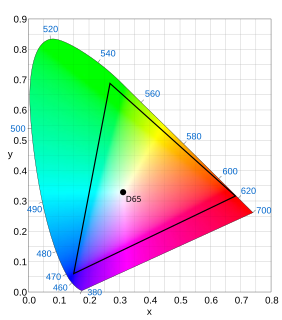
Electronic paper, also sometimes electronic ink or electrophoretic display, are display devices that mimic the appearance of ordinary ink on paper. Unlike conventional flat panel displays that emit light, electronic paper displays reflect light like paper. This may make them more comfortable to read, and provide a wider viewing angle than most light-emitting displays. The contrast ratio in electronic displays available as of 2008 approaches newspaper, and newly (2008) developed displays are slightly better. An ideal e-paper display can be read in direct sunlight without the image appearing to fade.

A liquid-crystal display (LCD) is a flat-panel display or other electronically modulated optical device that uses the light-modulating properties of liquid crystals combined with polarizers. Liquid crystals do not emit light directly, instead using a backlight or reflector to produce images in color or monochrome. LCDs are available to display arbitrary images or fixed images with low information content, which can be displayed or hidden, such as preset words, digits, and seven-segment displays, as in a digital clock. They use the same basic technology, except that arbitrary images are made from a matrix of small pixels, while other displays have larger elements. LCDs can either be normally on (positive) or off (negative), depending on the polarizer arrangement. For example, a character positive LCD with a backlight will have black lettering on a background that is the color of the backlight, and a character negative LCD will have a black background with the letters being of the same color as the backlight. Optical filters are added to white on blue LCDs to give them their characteristic appearance.
A flat-panel display (FPD) is an electronic display device used to enable people to see content in a range of entertainment, consumer electronics, personal computer, and mobile devices, and many types of medical, transportation and industrial equipment. They are far lighter and thinner than traditional cathode ray tube (CRT) television sets and are usually less than 10 centimetres (3.9 in) thick. Flat-panel displays can be divided into two display device categories: volatile and static. Volatile displays require that pixels be periodically electronically refreshed to retain their state. A volatile display only shows an image when it has battery or AC mains power. Static flat-panel displays rely on materials whose color states are bistable, and as such, flat-panel displays retain the text or images on the screen even when the power is off. As of 2016, flat-panel displays have almost completely replaced old CRT displays. In many 2010-era applications, specifically small portable devices such as laptops, mobile phones, smartphones, digital cameras, camcorders, point-and-shoot cameras, and pocket video cameras, any display disadvantages of flat-panels are made up for by portability advantages.
An e-reader, also known as an e-book reader, is a portable electronic device that is designed primarily for the purpose of reading e-books and periodicals. E-readers have a similar form factor to a tablet and usually refers to devices that use electronic paper resulting in better screen readability, especially in bright sunlight, and longer battery life when compared to a tablet. An e-reader's battery will typically last for multiple weeks. In contrast to an e-reader, a tablet has a screen capable of higher refresh rates which make them more suitable for interaction such as playing a video game or watching a video clip.
DigitalEurope is the European organisation that represents the digital technology industry whose members include 61 major technology companies and 37 national trade associations. It seeks to ensure industry participation in the development and implementation of EU policies" and has several working groups that focus on different aspects of policy—environment, trade, technical and regulatory and the digital economy. Based in Brussels, Belgium, DigitalEurope represents over 10,000 companies with a combined annual revenue of over €3 trillion.

E Ink is a brand of electronic paper (e-paper) display technology commercialized by the E Ink Corporation, which was co-founded in 1997 by MIT undergraduates JD Albert and Barrett Comiskey, MIT Media Lab professor Joseph Jacobson, Jerome Rubin and Russ Wilcox.

A flexible display or rollable display is an electronic visual display which is flexible in nature, as opposed to the traditional flat screen displays used in most electronic devices. In recent years there has been a growing interest from numerous consumer electronics manufacturers to apply this display technology in e-readers, mobile phones and other consumer electronics. Such screens can be rolled up like a scroll without the image or text being distorted. Technologies involved in building a rollable display include electronic ink, Gyricon, Organic LCD, and OLED.

Plastic Logic Germany develops and manufactures electrophoretic displays (EPD), based on organic thin-film transistor (OTFT) technology, in Dresden, Germany.
Interferometric modulator display is a technology used in electronic visual displays that can create various colors via interference of reflected light. The color is selected with an electrically switched light modulator comprising a microscopic cavity that is switched on and off using driver integrated circuits similar to those used to address liquid crystal displays (LCD). An IMOD-based reflective flat panel display includes hundreds of thousands of individual IMOD elements each a microelectromechanical systems (MEMS)-based device.
Digital newspaper technology is the technology used to create or distribute a digital newspaper.
PocketBook is a multinational company which produces e-book readers based on E Ink technology under the PocketBook brand.
PenTile matrix is a family of patented subpixel matrix schemes used in electronic device displays. PenTile is a trademark of Samsung. PenTile matrices are used in AMOLED and LCD displays.

4K resolution refers to a horizontal display resolution of approximately 4,000 pixels. Digital television and digital cinematography commonly use several different 4K resolutions. In television and consumer media, 3840 × 2160 is the dominant 4K standard, whereas the movie projection industry uses 4096 × 2160.

The Barnes & Noble Nook is a brand of e-readers developed by American book retailer Barnes & Noble, based on the Android platform. The original device was announced in the U.S. in October 2009, and was released the next month. The original Nook had a six-inch E-paper display and a separate, smaller color touchscreen that serves as the primary input device and was capable of Wi-Fi and AT&T 3G wireless connectivity. The original nook was followed in November 2010 by a color LCD device called the Nook Color, in June 2011 by the Nook Simple Touch, and in November 2011 and February 2012 by the Nook Tablet. On April 30, 2012, Barnes & Noble entered into a partnership with Microsoft that spun off the Nook and college businesses into a subsidiary. On August 28, 2012, Barnes and Noble announced partnerships with retailers in the UK, which began offering the Nook digital products in October 2012. In December 2014, B&N purchased Microsoft's Nook shares, ending the partnership.

Google Play Books, formerly Google eBooks, is an ebook digital distribution service operated by Google, part of its Google Play product line. Users can purchase and download ebooks and audiobooks from Google Play, which offers over five million titles, with Google claiming it to be the "largest ebooks collection in the world". Books can be read on a dedicated Books section on the Google Play website, through the use of a mobile app available for Android and iOS, through the use of select e-readers that offer support for Adobe Digital Editions, through a web browser and reading via Google Home. Users may also upload up to 2,000 ebooks in the PDF or EPUB file formats. Google Play Books is available in 75 countries.

The Samsung Electronics Co., Ltd. is a South Korean multinational electronics company headquartered in the Yeongtong District of Suwon. It is the pinnacle of the Samsung chaebol, accounting for 70% of the group's revenue in 2012. Samsung Electronics has played a key role in the group's corporate governance due to circular ownership. Samsung Electronics has assembly plants and sales networks in 74 countries and employs around 290,000 people. It is majority-owned by foreign investors. It is the world's largest manufacturer of consumer electronics by revenue. As of 2019, Samsung Electronics is the world's second largest technology company by revenue, and its market capitalization stood at US$520.65 billion, the 12th largest in the world.

DCI-P3, or DCI/P3, is a common RGB color space for digital movie projection from the American film industry.
High-dynamic-range video is video having a dynamic range greater than that of standard-dynamic-range video. HDR video involves capture, production, content/encoding, and display. HDR capture and displays are capable of brighter whites and deeper blacks. To accommodate this, HDR encoding standards allow for a higher maximum luminance and use at least a 10-bit dynamic range in order to maintain precision across this extended range.
The Samsung Galaxy A60 and Samsung Galaxy M40 are Android phablets manufactured by Samsung Electronics as part of its fifth-generation Galaxy A series lineup and first-generation Galaxy M series lineup. The phones come with Android 9 (Pie) with Samsung's proprietary One UI skin, 64 or 128 GB of internal storage, and a 3500 mAh battery. The A60 is marketed for China, while the M40 is marketed for India and other countries. The A60 and M40 are identical except for colors, pricing, RAM and LTE bands. The A60 was unveiled on April 17, 2019, while the M40 was unveiled on June 11, 2019.

The Samsung Galaxy A31 is a mid-range Android smartphone developed by Samsung Electronics as part of their 2020 A-series smartphone lineup. It was announced on March 24, 2020, and first released on April 27, 2020 as the successor to the Galaxy A30 and A30s. The phone comes preinstalled with Android 10 and Samsung’s custom One UI 2.1 software overlay.









